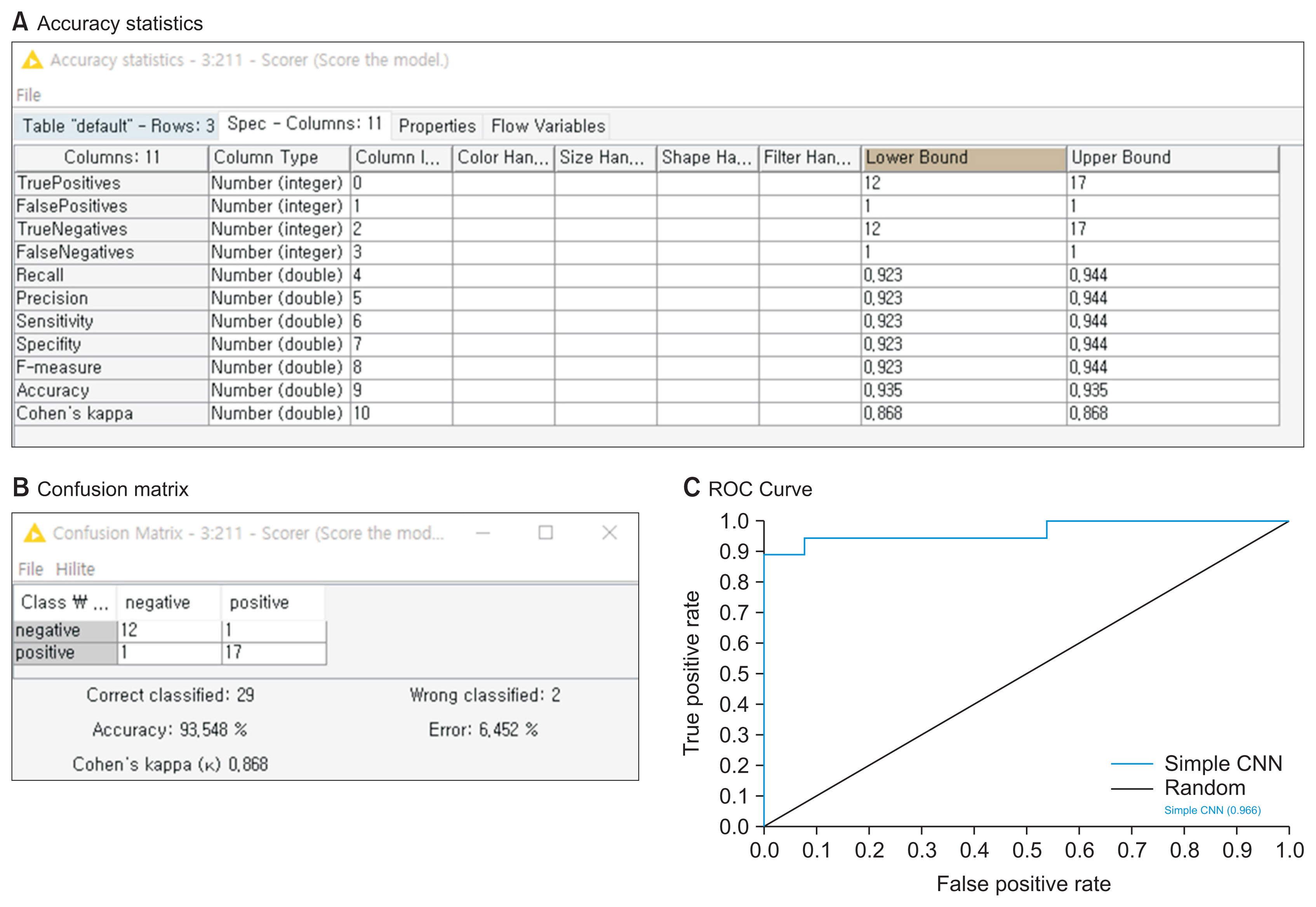Healthc Inform Res.
2021 Jan;27(1):82-91. 10.4258/hir.2021.27.1.82.
Codeless Deep Learning of COVID-19 Chest X-Ray Image Dataset with KNIME Analytics Platform
- Affiliations
-
- 1Institute of Medical & Biological Engineering, Medical Research Center, Seoul National University College of Medicine, Seoul, Korea
- 2Department of Biomedical Engineering, Chungnam National University College of Medicine, Daejeon, Korea
- 3Transdisciplinary Department of Medicine and Advanced Technology, Seoul National University Hospital, Seoul, Korea
- 4Department of Surgery, Seoul National University College of Medicine, Seoul, Korea
- 5Department of Biomedical Engineering, Seoul National University College of Medicine, Seoul, Korea
- KMID: 2512628
- DOI: http://doi.org/10.4258/hir.2021.27.1.82
Abstract
Objectives
This paper proposes a method for computer-assisted diagnosis of coronavirus disease 2019 (COVID-19) through chest X-ray imaging using a deep learning model without writing a single line of code using the Konstanz Information Miner (KNIME) analytics platform.
Methods
We obtained 155 samples of posteroanterior chest X-ray images from COVID-19 open dataset repositories to develop a classification model using a simple convolutional neural network (CNN). All of the images contained diagnostic information for COVID-19 and other diseases. The model would classify whether a patient was infected with COVID-19 or not. Eighty percent of the images were used for model training, and the rest were used for testing. The graphic user interface-based programming in the KNIME enabled class label annotation, data preprocessing, CNN model training and testing, performance evaluation, and so on.
Results
1,000 epochs training were performed to test the simple CNN model. The lower and upper bounds of positive predictive value (precision), sensitivity (recall), specificity, and f-measure are 92.3% and 94.4%. Both bounds of the model’s accuracies were equal to 93.5% and 96.6% of the area under the receiver operating characteristic curve for the test set.
Conclusions
In this study, a researcher who does not have basic knowledge of python programming successfully performed deep learning analysis of chest x-ray image dataset using the KNIME independently. The KNIME will reduce the time spent and lower the threshold for deep learning research applied to healthcare.
Figure
Reference
-
References
1. Grand View Research. Artificial intelligence in healthcare market size, share & trends analysis report by component (hardware, software, services), by application, by region, competitive insights, and segment forecasts, 2019–2025 [Internet]. San Francisco (CA): Grand View Research;2019. [cited at 2021 Jan 27]. Available from: https://www.grand-viewresearch.com/industry-analysis/artificial-intelligence-ai-healthcare-market?utm_source=prnewswire&utm_medium=referral&utm_campaign=hc_16-dec-19&utm_term=ai-healthcare-market&utm_content=rd/toc.2. Guo Y, Hao Z, Zhao S, Gong J, Yang F. Artificial intelligence in health care: bibliometric analysis. J Med Internet Res. 2020; 22(7):e18228.
Article3. Jiang F, Jiang Y, Zhi H, Dong Y, Li H, Ma S, et al. Artificial intelligence in healthcare: past, present and future. Stroke Vasc Neurol. 2017; 2(4):230–43.
Article4. Fontani D. Keras UI: a GUI to manage image classification [Internet] [place unknown]. Code Project. 2019. [cited at 2021 Jan 27]. Available from: https://www.codeproject.com/Articles/4053651/Keras-UI-A-GUI-to-Manage-Image-Classification.5. Blume PA. The LabVIEW style book. Boston (MA): Prentice-Hall;2011.6. Frank E, Hall M, Holmes G, Kirkby R, Pfahringer B, Witten IH, et al. Weka: a machine learning workbench for data mining. Maimon O, Rokach L, editors. Data mining and knowledge discovery handbook. Boston (MA): Springer;2009. p. 1269–77.7. KNIME Analytics Platform [Internet]. Zurich, Switzerland: KNIME AG;c2020. [cited at 2021 Jan 27]. Available from: https://www.knime.com/knime-analytics-platform.8. Lin Q, Zhao S, Gao D, Lou Y, Yang S, Musa SS, et al. A conceptual model for the coronavirus disease 2019 (COVID-19) outbreak in Wuhan, China with individual reaction and governmental action. Int J Infect Dis. 2020; 93:211–6.
Article9. RSNA pneumonia detection challenge [Internet]. San Francisco (CA): Kaggle.com;2018. [cited at 2021 Jan 27]. Available from: https://www.kaggle.com/c/rsna-pneumonia-detection-challenge.10. Cohen JP, Morrison P, Dao L, Roth K, Duong TQ, Ghassemi M. Covid-19 image data collection: prospective predictions are the future [Internet]. Ithaca (NY): arXiv.org;2020. [cited at 2020 Jan 28]. Available from: https://arxiv.org/abs/2006.11988.11. Shaheen F, Verma B, Asafuddoula M. Impact of automatic feature extraction in deep learning architecture. In : Proceedings of 2016 International Conference on Digital Image Computing: Techniques and Applications (DICTA); 2016 Nov 30–Dec 2; Gold Coast, Australia. p. 1–8.
Article12. Vinayakumar R, Soman KP, Poornachandran P. Applying convolutional neural network for network intrusion detection. In : Proceedings of 2017 International Conference on Advances in Computing, Communications and Informatics (ICACCI); 2017 Sep 13–16; Udupi, India. p. 1222–8.
Article13. Swapna G, Soman Kp, Vinayakumar R. Automated detection of diabetes using CNN and CNN-LSTM network and heart rate signals. Procedia computer science. 2018; 132:1253–62.
Article14. Gao T. Chest X-ray image analysis and classification for COVID-19 pneumonia detection using deep CNN. medRxiv. 2020. [Epub]. https://doi.org/10.1101/2020.08.20.20178913.
Article15. Ismael AM, Sengur A. Deep learning approaches for COVID-19 detection based on chest X-ray images. Expert Syst Appl. 2021; 164:114054.
Article16. Maghdid HS, Asaad AT, Ghafoor KZ, Sadiq AS, Khan MK. Diagnosing COVID-19 pneumonia from X-ray and CT images using deep learning and transfer learning algorithms [Internet]. Ithaca (NY): arXiv.org;2020. [cited at 2020 Jan 28]. Available from: https://arxiv.org/abs/2004.00038.17. Phillips NA, Rajpurkar P, Sabini M, Krishnan R, Zhou S, Pareek A, et al. Chexphoto: 10,000+ smartphone photos and synthetic photographic transformations of chest x-rays for benchmarking deep learning robustness [Internet]. Ithaca (NY): arXiv.org;2020. [cited at 2020 Jan 28]. Available from: https://arxiv.org/abs/2007.06199.
- Full Text Links
- Actions
-
Cited
- CITED
-
- Close
- Share
- Similar articles
-
- Artificial neural networks for the detection of odontoid fractures using the Konstanz Information Miner Analytics Platform
- Clinical Implementation of Deep Learning in ThoracicRadiology: Potential Applications and Challenges
- Application of deep learning algorithm to detect COVID-19 pneumonia in chest X-ray
- Implementation of a Deep Learning-Based ComputerAided Detection System for the Interpretation of Chest Radiographs in Patients Suspected for COVID-19
- AI-powered COVID-19 forecasting: a comprehensive comparison of advanced deep learning methods








